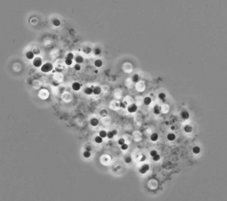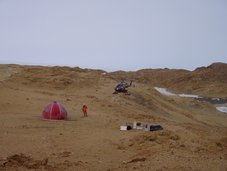Astrobiology: Habitability and biosignatures




Background
Astrobiology is an interdisciplinary research topic that deals with fundamental questions about the development of life, and the physical and chemical conditions that influence this process. Astrobiology research looks beyond Earth trying to understand the development of life in general and searching for possible traces of life on other planets.
The particular focus of the geomicrobiological work at the GFZ is on habitability studies and determing biosignatures in natural environments and in simulation experiments. Extreme habitats on Earth with expected analogs on other planets and moons in our solar system play an important role in our astrobiological research. This includes, for example, habitats that are characterized by extreme drought and/or cold such as the Atacama Desert in Chile, ice-free oases in Antarctica or Arctic permafrost (see also topics 1 - 3). The Geomicrobiology Section owns a unique culture collection of microorganisms from these extreme habitats. Due to their adaptation to the extreme conditions of their environment, these microorganisms are particularly suitable as models for possible life outside Earth. Therefore, they are used in corresponding simulation experiments. This also includes low-Earth orbit experiments on the International Space Station (ISS).
In recent years an active research network has been established in the Potsdam-Berlin region with Geo.X partners (www.geo-x.net), which conducts joint astrobiological research on habitability and biosignatures. Amongst others an ESA experiment has recently been carried out on board the International Space Station (ISS), which is currently being analyzed in the participating laboratories.
Scientific key questions
- Which strategies evolved within extremophilic microorganisms that enable their survival under extreme conditions on Earth?
- Can methanogenic archaea from permafrost habitats exist under the climatic conditions of Mars?
- What role do microorganisms play for the initial development of habitats on a planet?
Study sites
- Permafrost areas in the Arctic
- Cold deserts in Antarctica (Larsemann Hills)
- Atacama Desert, Chile
Projects
- ESA BioSigN: Bio-Signatures and habitable Niches
- Becas Chile/DAAD: Impact of Multiple Environmental Stressors on the Assembly and Functional Diversity of Microbial Communities in Initial Soil Ecosystems at the Puna de Atacama, Atacama Region, Chile
Partners
Dr. Jean-Pierre de Vera, German Aerospace Centre (DLR), Germany
Prof. Dr. Dirk Schulze-Makuch, Technical University Berlin (TUB) and GFZ Holmholtz Centre for Geosciences